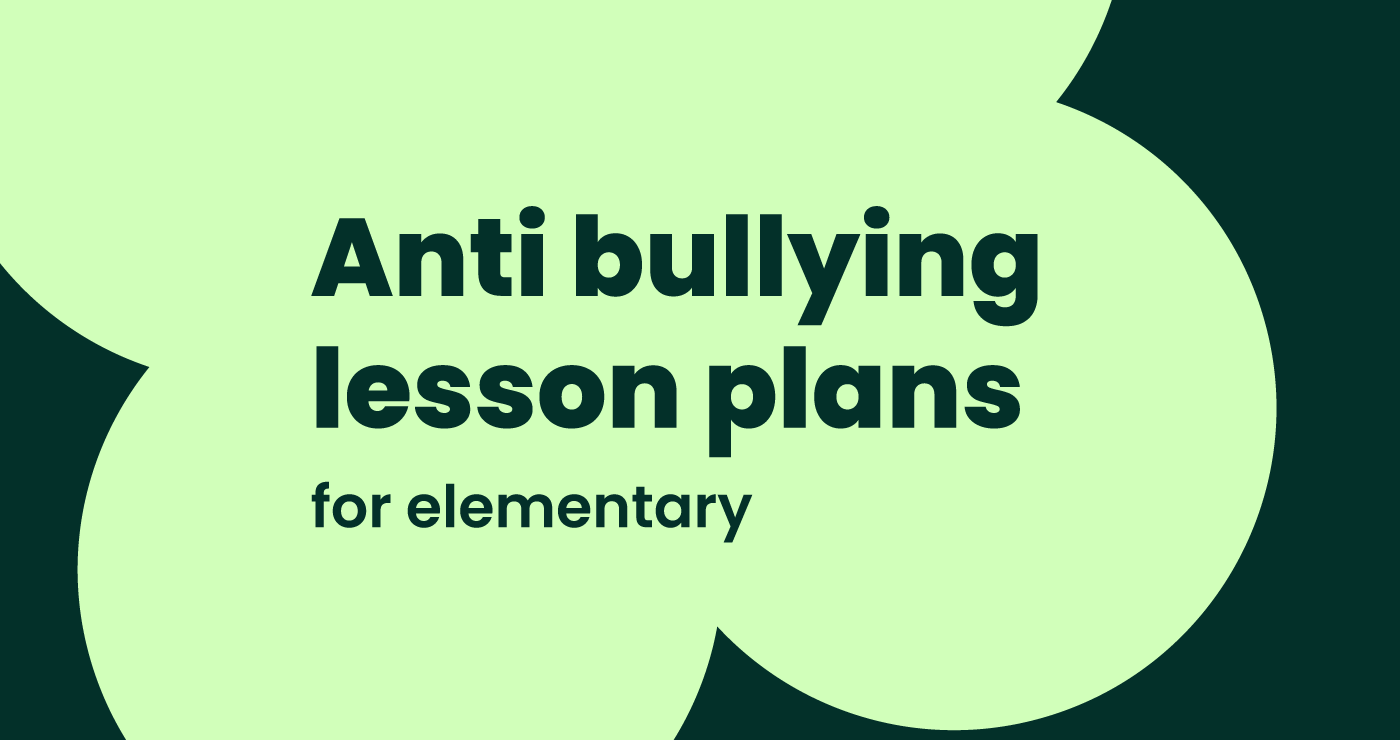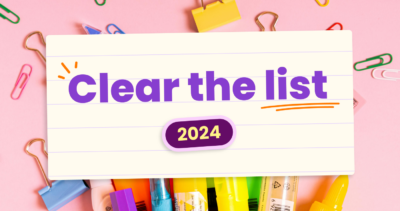Anti-Bullying Lesson Ideas for Elementary Classes

According to the National Center for Educational Statistics (NCES), one out of every five students reports being the victim of bullying behavior.
Deep into the digital age, perpetrators now have a powerful platform from which to bully their victims, with the added “advantage” of anonymity. According to a 2020 study , over 20% of 9 to 12-year-olds have been cyberbullied, partaken in cyberbullying themselves, or have witnessed the behavior online/ on social media.
It’s imperative that schools take a considered and committed approach to educating children on all aspects of bullying, and this should begin at elementary school age to best combat the issue and stop bullying. This is one crucial step toward creating a positive school culture. If you’d like to know more about this, have a read of our Creating a Positive School Culture blog.

What is bullying?
The American Psychological Association (APA) defines bullying as “a form of aggressive behavior in which someone intentionally and repeatedly causes another person injury or discomfort. Bullying can take the form of physical contact, words, or more subtle actions.”
Generally speaking, bullies target vulnerable children with noticeable differences, such as in appearance and preferences; for example, disabilities and gender dysphoria are common targets for cruel treatment.
The scope of bullying has also widened in recent years, with differences as minute as food allergies attracting negative attention. Unfortunately, around a third of children with allergies report being bullied because of it.
As Jess Grelle, SVP of Innovation at allergy-friendly company Safe + Fair says, “ Not only are allergies surprisingly common, but they can be life-threatening and certainly no joke. Our mission to normalize allergy-friendly eating through trustworthy, transparent products will hopefully help to prevent such instances of mindless bullying of children suffering from allergies . ”
Teaching elementary children about bullying
The primary aim of educating elementary children about bullying is to teach students:
- to understand what bullying is (and what it isn’t)
- to be able to identify different types of bullying
- to recognize the importance of reaching out and how to
- to consider how best to support someone they see being bullied while staying safe
Here are some key components for effective elementary anti-bullying education lessons:
Understanding bullying
Get pupils to discuss (in pairs or small groups) the question, “What is bullying?” You can also provide other bullying-related discussion questions and ask your grade level or middle school students to think of bullying situations.
It’s also important to discuss and help the students to understand what bullying is not. For example, accidentally bumping into someone and then apologizing to them is not an act of bullying, while intentionally knocking someone to intimidate them or cause them harm or embarrassment IS a form of bullying.
Be sure to include examples of cyberbullying . The Oxford Dictionary defines cyberbullying as “the use of electronic communication to bully a person, typically by sending messages of an intimidating or threatening nature.”
Who is vulnerable to being bullied?
Discuss which children are typically the most vulnerable to being bullied. Ask the children to discuss this in pairs or groups and then share it with the class and discuss.
- Discuss differences and explore reasons to see them as valuable and positive
- Discuss disabilities and differences such as autism and what they mean, including those that aren’t visibly obvious, such as epilepsy or serious allergies
What does it look and feel like to be bullied?
Explore with the children aspects of what it looks like and feels like to be bullied, and fill in the gaps, to include the following points:
- Being called mean names or sent mean messages
- Having mean rumors started about you
- Being left out of groups
- Being hit, kicked, or punched
- Having your belongings damaged or destroyed
- Having other children make fun of the way you talk, act, or look
- Feeling afraid to go to school
- Being laughed at when you are hurt or embarrassed
- Being made fun of for being better or worse at something than other children
- Being made to do something you don’t want to do because of unkind peer pressure
Explore the emotions that this would cause, such as embarrassment, anxiety, fear, shame, loneliness, etc.
What does it look and feel like to be a bully?
It’s also extremely important to explore what it means to be a bully. Teachers should let the children know that they are welcome and safe to talk one-on-one about this in confidence.
Bullying traits include:
- Name-calling
- Starting rumors about others
- Trying to embarrass other children
- Purposely leaving kids out of groups or games
- Stealing and/or damaging other children’s things
- Wanting to make another child feel upset or scared
- Pushing or hitting another child
- Saying mean things about another child to make them look bad
- Getting other kids to be mean to others with you
- Wanting other kids to feel afraid of you
- Making fun of how another child talks, acts, or looks
- Thinking it’s cool to laugh at others
- Enjoying other people laughing with you at others
- Sending mean messages online or via text
Reaching out
A key aspect of anti-bullying education is teaching children about what to do in the event that they are bullied or are a bystander or witness someone else being victimized by a bully or bullies.
It’s also important to point out that another excellent reason for reaching out is in the event that a child is involved in bullying behavior and wants to stop.
Discuss effective conflict resolution and the following considerations regarding reaching out:
- Friends – perhaps they think a friend is being bullied, but they are not sure. Explore why reaching out and asking the friend if everything is ok might make an important difference
- Teachers and other school staff – discuss why it might help to tell a teacher or other school staff member like a school counselor about someone being bullied, and use this as an opportunity to clearly outline the school’s specific approach to reporting bullying (as well as making it fundamentally clear that any form of speaking out is encouraged)
- Parents and caregivers – discuss how it might make a difference to talk to a parent or other caregiver about bullying in school or online. Talk about the importance of telling someone and not staying silent.
In some instances, a child may be too embarrassed or afraid to admit that they are being bullied. Discuss the impact of staying silent on the failure to combat the issue at large.
Cross-curricular bullying lesson ideas
A great way to incorporate education around bullying into everyday conversations is to develop classroom activities and cross-curricular lesson plans; this is particularly impactful when built around National bullying prevention month. Ideas include:
Assign the children a creative writing task in the language arts, centered around a short story or play about bullying, friendship, inclusion, etc. Give them points that must be included, such as a bullying incident, an act of reaching out, etc.
Another great idea is to write poetry on the topic of bullying.
The impact of kindness and thoughtfulness can be explored in an expansive way by considering how humans’ actions affect animals, nature, the environment, and the planet at large, drawing similarities with the negative ripple effect that can occur as a result of bullying.
If the students have access to computers or iPads, you could set them the task of researching animals that live in groups, working together to survive. For example, some animals huddle together to stay warm, and many work together to hunt for food and transport it back to their family. The children could create presentations on their findings, and discuss how these patterns relate to the need for humans to support one another.
Physical education
Phys. Ed. offers up plenty of opportunities for easily incorporating themes of inclusion, respect, and fairness. Try literally ‘changing the goalposts’ – change rules, have more players on one team than another, play around with how team members are chosen, etc., all with an emphasis on how unfairness can impact individuals, teams, outcomes, morale, and more.
With art, the options are virtually endless. Assign students the task of painting or drawing their own abstract interpretation of how it would feel to be bullied, the relief of reaching out, the shame of being a bully, the relief and pride of changing that behavior, etc.
There are countless stories from history that can effectively demonstrate the damage that unkind actions cause.
Martin Luther King’s life and civil rights protests offer up plenty of discussion points. Discuss how and why he specifically promoted the dedication to non-violent resistance and why it was so important that he demonstrated kindness and respect to all, regardless of their behavior towards him.

Design technology
Engage the students in designing areas and concepts that prioritize inclusion , safety, accountability, etc. School facilities, quiet areas, lunch halls, yards, or other open spaces.
Final thoughts
Early education is surely one of the keys to combating bullying most effectively. By engaging elementary school-age children with key concepts and strategies, a solid foundation of understanding can be created that can continue through their schooling years into high school and their professional development.
There are many ways in which teachers and schools can incorporate anti-bullying messages and education into lessons and school ethos, using fun methods that can further drive the messages home in a memorable way. Why not create a handout, worksheet, bulletin board, or toolkit on teaching tolerance and kindness?
If you are an elementary teacher who feels that your school could be doing more to educate on bullying issues , discuss your vision with other teachers and take ideas to the Principal for consideration. And in the meantime, foster an ethos of kindness, self-esteem, respect, and safety in your classroom.
You may also like

A new chapter of growth for Kami

#ClearTheList: Transform Classrooms with Amazon Wishlist Clearing

Forward Focus: The Future is Now
- International
- Education Jobs
- Schools directory
- Resources Education Jobs Schools directory News Search

- Bullying and Anti-Bullying PowerPoint Presentation
Subject: Understanding the world
Age range: 6 - 11
Resource type: Visual aid/Display
Last updated
7 June 2023
- Share through email
- Share through twitter
- Share through linkedin
- Share through facebook
- Share through pinterest

Through this presentation, students will be introduced to a comprehensive overview of bullying, including its definition, various types, and the roles of victims and followers. They will gain valuable insights into how they can effectively support others in combating bullying and understand the impact their own behaviors can have, whether as part of the problem through silence or as part of the solution by providing assistance.
This presentation promotes understanding, fosters a positive classroom culture, and builds a strong sense of community among your students
The slides are designed to engage and educate students on the concept of bullying while empowering them to take a stand against it.
Furthermore, it encourages you to create a safe space for your students to share their personal experiences and perspectives on bullying. By actively listening to their stories, you can help them gain awareness and guide them toward becoming proactive participants who raise their voices against bullying.
This resource includes:
- Slide 1: What is Bullying?
- Slide 2: Types of Bullying
- Slide 3: Physical Bullying
- Slide 4: Cyberbullying
- Slide 5: Verbal Bullying
- Slide 6: Social Bullying
- Slide 7: Who is a Bully?
- Slide 8: Bully Supporters and Followers
- Slide 9: Victims of Bullying
- Slide 10: What Can You Do When You See Someone Being Bullied?
- Slide 11: STOP Bullying - How do I Treat Others?
- Slide 12: I Have Learned about - Bullying and Anti-Bullying
- Google Slides
"----------------------------------- ★ Related Resources:
- Download the Spanish Version
-----------------------------------"
"---------------------------------- ★ You may like these resources:
- Bullying Mindmap
- Anti-Bullying Activity
------------------------------------"
Happy Anti-Bullying Day!
Tes paid licence How can I reuse this?
Get this resource as part of a bundle and save up to 34%
A bundle is a package of resources grouped together to teach a particular topic, or a series of lessons, in one place.
Bullying and Anti-Bullying Collection BUNDLE
This comprehensive package provides essential information for clearly defining bullying to your students and emphasizes that such behavior is unacceptable and will have consequences. It is an excellent tool for preventing and stopping bullying, as it fosters a safe environment where children can thrive socially and academically without fear. The activities empower children to identify the signs of a bully, avoid engaging in bullying themselves, and understand the appropriate steps to take if they encounter bullying at school. In some instances, children may not openly express that they are being bullied. This resource equips your students with strategies to handle bullying situations and encourages them to seek support from trusted teachers and friends if they have concerns about bullying. By utilizing this resource, your students and the entire class will enhance their social and academic achievements, enabling them to thrive in various aspects of their lives. >>>>> **This collection includes the following resources:** * Resource 1: Bullying and Anti-Bullying PowerPoint Presentation * Resource 2: Anti-Bullying Activity * Resource 3: Bullying Mind Map >> *Happy Anti-Bullying Day!*
Bullying and Anti-Bullying PowerPoint Presentation BUNDLE
This resource includes an English and Spanish version of the Bullying and Anti-Bullying PowerPoint Presentation. These are perfect for your bilingual or dual-language classrooms and schools! Through this presentation, students will be introduced to a comprehensive overview of bullying, including its definition, various types, and the roles of victims and followers. They will gain valuable insights into how they can effectively support others in combating bullying and understand the impact their own behaviors can have, whether as part of the problem through silence or as part of the solution by providing assistance. This presentation promotes understanding, fosters a positive classroom culture, and builds a strong sense of community among your students The slides are designed to engage and educate students on the concept of bullying while empowering them to take a stand against it. The two resources I am including in this bundle are sold separately. Below is the list of what you will receive. You can click on each link to read a detailed description of each product. >>> **This resource includes:** * Slide 1: What is Bullying? (English and Spanish Version) * Slide 2: Types of Bullying (English and Spanish Version) * Slide 3: Physical Bullying (English and Spanish Version) * Slide 4: Cyberbullying (English and Spanish Version) * Slide 5: Verbal Bullying (English and Spanish Version) * Slide 6: Social Bullying (English and Spanish Version) * Slide 7: Who is a Bully? (English and Spanish Version) * Slide 8: Bully Supporters and Followers (English and Spanish Version) * Slide 9: Victims of Bullying (English and Spanish Version) * Slide 10: What Can You Do When You See Someone Being Bullied? (English and Spanish Version) * Slide 11: STOP Bullying - How do I Treat Others? (English and Spanish Version) * Slide 12: I Have Learned about - Bullying and Anti-Bullying (English and Spanish Version) >> **Formats:** * Powerpoint * PDF * Google Slides * Keynote * JPG images *Happy Anti-Bullying Day!*
Your rating is required to reflect your happiness.
It's good to leave some feedback.
Something went wrong, please try again later.
This resource hasn't been reviewed yet
To ensure quality for our reviews, only customers who have purchased this resource can review it
Report this resource to let us know if it violates our terms and conditions. Our customer service team will review your report and will be in touch.
Not quite what you were looking for? Search by keyword to find the right resource:

COMMENTS
Watch these four animated videos which creatively illustrate what it feels like to be bullied, what students can do if they see bullying, and how to be an advocate against bullying. Then hold a …
These free educational and interactive bullying prevention resources are designed for K-12 learners and the parents and educators who support and educate them. Can be used in the …
Prepare an anti-bullying campaign and spread an inspiring message to your students. This template is full of children’s illustrations and it’ll convey the anti-bullying message clearly. Edit …
Free Google Slides theme, PowerPoint template, and Canva presentation template. Advocating for a better and kinder world starts with teaching children about tolerance and respect. Prepare an anti-bullying campaign and spread …
Here are some key components for effective elementary anti-bullying education lessons: Understanding bullying. Get pupils to discuss (in pairs or small groups) the question, “What is bullying?” You can also provide other bullying …
These anti-bullying videos help start conversations and provide kids with new points of view. There’s something here for every age, so choose a few to share with your students as part of a larger program to address bullying.
Through this presentation, students will be introduced to a comprehensive overview of bullying, including its definition, various types, and the roles of victims and followers.